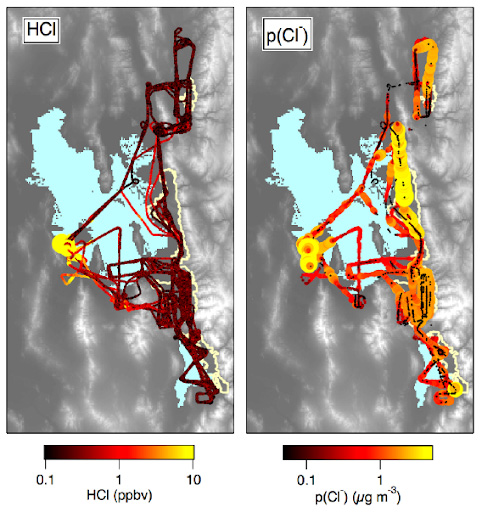The Great Salt Lake Basin is meteorologically and chemically distinct from other regions in the U.S. It is subject to both persistent cold air pools in complex terrain that lead to winter air pollution and potentially large inputs of natural and anthropogenic sources of halogen species.
Here we propose to investigate the role of these halogen sources in regulating the severity of winter PM2.5. Aircraft and ground-based measurements from the 2017 Utah Winter Fine Particulate Study (UWFPS) provided state of the art measurements of speciated halogens, including the di-halogens (Cl2, Br2, etc.), nitryl halides (ClNO2) and hydrochloric acid (HCl), among others.
We propose a two-part analysis to leverage these unique measurements. The first phase will investigate the magnitude of industrial emissions of chlorine and bromine to better constrain emissions inventories for these species. These emissions play a direct role in PM2.5 formation through gas-particle partitioning of chloride. They also play an indirect role in PM2.5 formation through the production of atmospheric radicals, which in turn drive oxidation cycles that lead to PM2.5. The second phase will assess the role of halogen emissions on ozone and other oxidants in the region adjacent to industrial facilities on the west shore of the Great Salt Lake, and more broadly across the Great Salt Lake and adjacent valleys. The goal of this analysis is to determine if there is a widespread effect of halogens on ozone, and if so, its influence on winter PM2.5, which itself is dependent on ozone.
The proposal is responsive to the goals and priorities of the UDAQ Science for Solutions program in the following areas:
- Emissions Inventory Improvements
- Halogen emission rate estimates for the Wasatch Front region
- PM2.5 Formation and Precursor Gases
- Halogens
- Oxidized nitrogen compounds
- Atmospheric radicals
- PM2.5 Chemical Composition and Sources
- Particulate chloride sources
The PIs for this proposal are from NOAA and its joint institute with the University of Colorado. These investigators led the measurements and analysis from UWFPS 2017. The proposal includes in-kind contribution from NOAA in the commitment of the principal investigator’s time at no cost. This analysis would not be easily supported absent funding from UDAQ.
- Principal Investigators: Steven S. Brown (NOAA), Caroline C. Womack (CIRES)
- Study Period: July 1, 2020, – June 30, 2021
- Funded by Science for Solutions Research Grant: $83,426
- DAQ Contact: Chris Pennell ([email protected])

